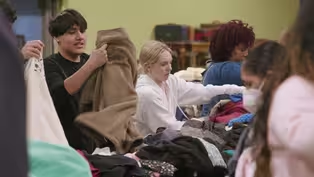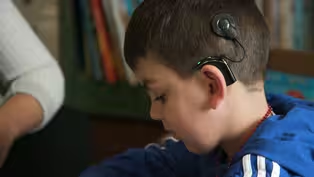
Sights & Sounds
Clip: Season 4 Episode 30 | 6m 46sVideo has Closed Captions
Those who have synesthesia say the way they view the world is unlike most people.
Imagine living in a world where music is not only heard but also seen. Words have flavors and colors have a smell. It’s a neurological condition called synesthesia. Those who have this crossover of the senses describe how it’s changed their perception of life.
Problems playing video? | Closed Captioning Feedback
Problems playing video? | Closed Captioning Feedback
Rhode Island PBS Weekly is a local public television program presented by Ocean State Media

Sights & Sounds
Clip: Season 4 Episode 30 | 6m 46sVideo has Closed Captions
Imagine living in a world where music is not only heard but also seen. Words have flavors and colors have a smell. It’s a neurological condition called synesthesia. Those who have this crossover of the senses describe how it’s changed their perception of life.
Problems playing video? | Closed Captioning Feedback
How to Watch Rhode Island PBS Weekly
Rhode Island PBS Weekly is available to stream on pbs.org and the free PBS App, available on iPhone, Apple TV, Android TV, Android smartphones, Amazon Fire TV, Amazon Fire Tablet, Roku, Samsung Smart TV, and Vizio.
Providing Support for PBS.org
Learn Moreabout PBS online sponsorshipwithout it, there would not be the magnificent art that we get to have all around us.
- [Host] Artist Alyn Carlson has a neurological condition that she says makes her life and her artwork more interesting.
- I was probably five and I started seeing numbers in color.
Three was yellow, five was red, zero was white.
Seven was sort of a purplely blue.
- Not only does Carlson see numbers in color but she says she can also hear them and smell them.
You've been open about the fact that you feel self-conscious somewhat even talking about this.
- Yeah, a little.
- Why is that?
- Well, it's kind of because other people can't really relate to it.
(classical music) - [Host] Artist and musician Lenny Peterson certainly can.
- [Lenny Peterson] So when I hear music, I see shapes.
- [Host] What kind of shapes?
- They are, well, they're in my art and they're anywhere from a straight line depending on the note to all kinds of atmosphere within squares and circles - [Host] Both Lenny Peterson and Alyn Carlson have synesthesia, a rare condition where a person's senses, including the sense of smell and sound, get mixed together.
We asked a neurologist, Dr. Richard Cytowic, to explain just what synesthesia is.
- It's pretty easy.
Everybody knows the word anesthesia which means no sensation.
So synesthesia means joined or coupled sensation.
And there are kids who are born with two, three, or all five of their senses hooked together.
So that my voice, for example, is not only something that they hear but something that they might also see, or taste, or feel as a physical touch.
- [Host] Carlson says, the artwork featured in her studio was created in large part thanks to her synesthesia.
Take for instance, this abstract painting.
Carlson says she painted it by mixing colors that smelled like one of her favorite things, a low tide.
- So I started to be able to pull in the whole family of those colors that smelled that way to me.
It was like an undercurrent in the whole palette.
And so from that I was, I painted a, you know, 80 inch wide abstract landscape just from the smell of those two colors that came together and that happened.
Boom, that was so fast.
- [Host] Synesthesia is more common than some might think.
Dr. Cytowic says 4% of the population has this union of the senses, including Lady Gaga.
♪ Poker face ♪ - [Host] And Billy Joel.
♪ We didn't start the fire ♪ - [Host] Russian writer Vladimir Nabokov, who wrote "Lolita" also had it.
(big band music) So did Composer and pianist, Duke Ellington.
Is synesthesia more common among artists and musicians?
- Well, you know, we're more familiar with famous artists who happen to be synesthetes than we are famous synesthetes who happen to be artists.
And it's a chicken and egg question of are they artistic because they're synesthetic or are they synesthetic because they're artistic?
But I think it's the former that and they're used to unusual things going together.
- It's those unusual things that inspire the work of artist Lenny Peterson.
He listens to music as he works and draws the shapes that he sees.
Now these shapes appear three dimensional in front of you?
They're floating in the air?
- They are being created in front of me.
They're not like in the, they're not in the room.
They're forming in front of me as I listen to music.
And the more I concentrate on it, the more they're gonna form and the clearer they're gonna form.
- [Host] Peterson's paintings are heavily influenced by the music he listens to.
(gentle music) - So this is specifically around a Miles Davis song, actually, called "In a Silent Way", and it's a very mystical kind of setting for this song.
Then the synesthesia kicks in here.
I start in the top left hand corner and my hand, I let my hand go.
And it's just a free flow of while the music's playing.
- Is it hereditary?
- Oh yes, absolutely, very strongly so.
It runs strongly in families.
Either sex parent can pass it down to either sex child and you'll see it in multiple generations.
- [Host] Colorful experiences can also evoke pleasant sounds.
For Alyn Carlson, this combination of blue has a distinct pitch.
- Every time I started to put them together, I would hear cello.
I would hear cello music.
Just a long note.
Just a long note, it's not a complicated piece of music.
- [Host] As the paint is being mixed.
- Yeah, as the paint is being mixed when I would get still with it, I would just hear it.
- What would a world without synesthesia look like for you?
- I don't know.
I probably wouldn't be, obviously doing what I do, making what I make.
I'd be lost.
I'd be really lost, I think.
- That's our broadcast this evening.
Thank you for joining us.
Green Seeker: Thrifty Business
Video has Closed Captions
Clip: S4 Ep30 | 6m 57s | Thrift shopping is back in style—especially among the eco-conscious. (6m 57s)
Video has Closed Captions
Clip: S4 Ep30 | 13m 5s | An in-depth look at how language deprivation can cause deaf children to fall behind. (13m 5s)
Providing Support for PBS.org
Learn Moreabout PBS online sponsorship
- News and Public Affairs

Top journalists deliver compelling original analysis of the hour's headlines.

- News and Public Affairs

FRONTLINE is investigative journalism that questions, explains and changes our world.












Support for PBS provided by:
Rhode Island PBS Weekly is a local public television program presented by Ocean State Media

